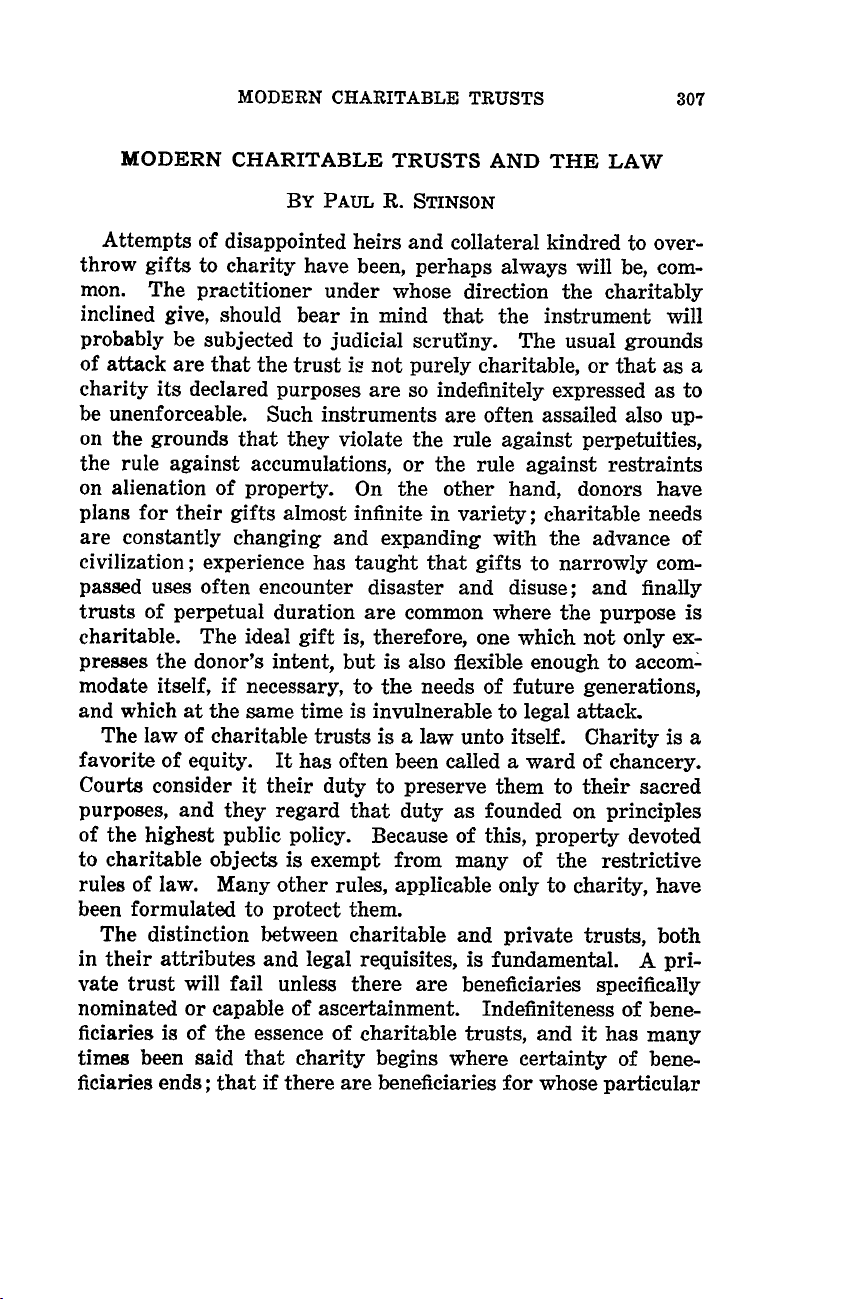









Study with the several resources on Docsity

Earn points by helping other students or get them with a premium plan


Prepare for your exams
Study with the several resources on Docsity

Earn points to download
Earn points by helping other students or get them with a premium plan
Community
Ask the community for help and clear up your study doubts
Discover the best universities in your country according to Docsity users
Free resources
Download our free guides on studying techniques, anxiety management strategies, and thesis advice from Docsity tutors
The validity of charitable trusts in Missouri, focusing on the indefiniteness of beneficiaries and the broad discretion granted to trustees. the historical background of charitable trusts, the role of the Elizabethan statute, and the evolution of the law in this area. It also highlights various court cases that have shaped the current legal landscape.
What you will learn
Typology: Lecture notes
1 / 13

This page cannot be seen from the preview
Don't miss anything!








MODERN CHARITABLE TRUSTS
Attempts (^) of disappointed heirs and collateral kindred to over- throw gifts to charity have (^) been, perhaps always will be, com- mon. The practitioner (^) under whose direction the charitably inclined (^) give, should bear in mind that the instrument will probably be subjected to judicial (^) scrutiny. The usual grounds of attack (^) are that the trust is not purely charitable, or that as a charity its declared purposes (^) are so indefinitely expressed as to be unenforceable. Such instruments are often assailed also (^) up- on the grounds that (^) they violate the rule against perpetuities, the rule against accumulations, or the rule against restraints on alienation of property. On the other hand, donors have plans for their (^) gifts almost infinite in variety; charitable needs are constantly changing and expanding with (^) the advance of civilization; experience (^) has taught that gifts to narrowly com- passed uses often encounter disaster (^) and disuse; and finally trusts of perpetual duration are common (^) where the purpose is charitable. The ideal (^) gift is, therefore, one which not only ex- presses (^) the donor's intent, but is also flexible enough to accom- modate itself, if necessary, to the needs of future generations, and (^) which at the same time is invulnerable to legal attack.
The law of charitable trusts is a law (^) unto itself. Charity is a favorite of equity. It has (^) often been called a ward of chancery.
Courts consider it their duty to preserve them to their (^) sacred purposes, and (^) they regard that duty as founded on principles of the (^) highest public policy. Because of this, property devoted
to charitable objects is exempt from (^) many of the restrictive
rules of law. Many other rules, applicable only to charity, (^) have been formulated (^) to protect them.
The distinction between charitable and private trusts, (^) both in their attributes and legal requisites, is fundamental. (^) A pri- vate trust will fail (^) unless there are beneficiaries specifically nominated or capable of ascertainment. (^) Indefiniteness of bene-
ficiaries is of the essence of charitable trusts, and it has (^) many
times been said that charity begins where certainty (^) of bene- ficiaries ends; that if there are beneficiaries for (^) whose particular
ST. LOUIS LAW REVIEW
4
1 See argument of Horace^ Binney^ in^ the^ case^ of^ Vidal^ v.^ Girard's Exec'rs. 2 (U. S.^ 1844)^2 How.^ 127. Dickey v. Volker (1928) 321 Mo. 235, 11 S. W. (2d) 278. 3 Jones v. Jones (1909) 223 Mo. 424, 1. c. 450, 123 S. W. 29. 4 Russell v. Allen (1882) 107 U. S. 163 (construing (^) a Missouri trust). 5 Chambers v. St. Louis (1860) 29 Mo. 543; Buchanan v. Kennard (1911) 234 Mo. 117, 136 S. W. 415. 6 Chambers v. St. Louis, supra; Howe v. Wilson (1886) 91 Mo. 45; 3 S. W. 390; Powell v. Hatch (1890) 100 Mo. 592, 14 S. W. 49; Barkley v. Donnelly (1892) 112 Mv. 561, 19 S. W. 305; Buckley v. Monck (Mo. 1916) 187 S. W.^ 31;^ Sappington v.^ School^ Fund^ Trustee^ (1894)^123 Mo.^ 32,^27 S. W. 356; Sandusky v. Sandusky (1914) 261 Mo. 351, 168 S.^ W.^ 1150; In re Rahn's Estate (1927) 316 Mo. 492, 291 S. W. 120; Harger v. Bar- rett (1928) 319 Mo. 633, 5 S. W. (2d) 1100; St. Louis Union Trust^ Co.^ v. Little (1928) 320 Mo. 1058,^10 S.^ W.^ (2d)^ 47. 7 Chambers v. St. Louis, supra; St. Louis Union Trust Co. v. Little, supra.
(^310) ST. LOUIS LAW REVIEW
itself. (^) The difference is only in degree, not in (^) principle. In either case, (^) the measure of control of the courts over the (^) trustee
is precisely the same. (^) In either instance, the trustee may violate his duties, and (^) the court may prevent or correct such violation
by restraint, or removal. While the limits (^) of charity are wider than those of any (^) of its divisions or branches, they are never-
theless as clearly defined. American courts (^) of equity are never called on to execute (^) or administer either until a breach has been committed or (^) is threatened. When this happens, the remedy (^) is
exactly the same, and equally efficacious. (^) A trust, therefore, for general charitable purposes (^) is neither too vague nor indefinite
for enforcement. Generality is not vagueness. A study (^) of recent cases discloses that the earlier (^) narrow judi- cial attitude of some courts toward trusts (^) for general charitable purposes, (^) has been relaxed in favor of a more (^) liberal view. There is a reason for this. Evolution has taken place in the art of public giving. Donations to perpetual charitable (^) objects have always been valid.' 0 No (^) man has ever been found wise enough accurately (^) to
forecast the needs of future generations. (^) Many great men who have sought to immortalize themselves (^) with their philanthropies have succeeded (^) only in perpetuating their mistakes. (^) In England
today, some twenty thousand English foundations have ceased to operate (^) because changing conditions have nullified (^) the good in-
tentions of their donors. (^) Julius Rosenwald said:
Millions-soon it will be billions-of (^) dollars are today ly- ing idle because the purposes for which (^) they have been endowed have largely disappeared. In the Bryan (^) Mullanphy will," the testator gave a huge (^) sum of money (^) in trust for the benefit of poor immigrants (^) passing
through St. Louis on their way (^) bona fide to settle in the West. Time (^) has paralyzed this trust's usefulness. Alexander Hamilton
drew the Randall will of the famous Sailor's Snug Harbor case,' 2 whereby the testator's (^) farm was given to be used as a haven
for superannuated sailors. Many years (^) later the cy-pres doc- trine had to be applied (^) to prevent a failure of the gift. Today
20 Russell v. Allen, supra. 3"Chambers (^) v. St. Louis, supra. 12 Inglis (^) v. Trustees of the Sailor's Snug Harbor (U. S. 1830) (^3) Pet. 99.
MODERN CHARITABLE TRUSTS
13Boston v.^ Doyle^ (1903)^^184 Mass.^ 373,^68 N.^ E.^ 851;^ Franklin^ v. Philadelphia (1893) 2 Pa. Dist. Reps. 435.
MODERN CHARITABLE TRUSTS
A Zollman, AMERICAN LAW OF CHARITIES, see. 394; Perry ON TRUSTS, (7th ed. 1929) sec. 711; Attorney General v. Soule (1873) 28 Mich. 153. Baptist Association v. Hart (U. S. 1819) 4 Wheat. 1. 1, Vidal v. Girard's Exec'rs., supra. '1The purposes enumerated by the Statute as charitable are "... (^) some for Relief of aged, impotent and poor People, some for Maintenance of sick and maimed Soldiers and Mariners, Schools of Learning, Free Schools, and Scholars in Universities, some for Repair of Bridges, Ports, Havens, Caus- ways, Churches, Sea-Banks and Highways, some for Education and Prefer- ment of Orphans, some for or towards Relief, Stock or Maintenance for Houses of Correction, some for Marriage of poor Maids, some for Sup- portation, Aid and Help of young Tradesmen,^ Handicrafts-men^ and^ Per- sons decayed, and others for Relief or Redemption of Prisoners or Cap- tives, and for Aid or Ease of any poor inhabitants concerning Payments of Fifteens, setting out of Soldiers and other Taxes." 1 Irwin v. Swinney (D. C. W. D. Mo. 1930) 44 F. (2d) 172, aff'd Gossett v. Swinney (C. C. A. 8, 1931) 53 F. (2d) 772; Buchanan v. Kennard, supra. -' (Mass. 1867) 14 Allen 539. 'Crow v. Clay County (1906) 196 Mo. 234, 1. c. 260, 95 S. W. 369; Newton v.^ Newton^ Burial^ Park^ (1930)^^326 Mo.^ 901,^34 S.^ W.^ (2d)^ 118; In re Rahn's Estate, supra; Catron v. Scarritt College (1914) 264 Mo. 713,
ST. LOUIS LAW REVIEW
A charity, in the legal sense, may be more fully defined as a gift, to be applied consistently with existing laws, for the benefit of an indefinite number of persons, either by bringing their minds and hearts under^ the^ influence^ of^ edu- cation or religion, by relieving their bodies from disease, suffering or constraint, by assisting them to establish them- selves in life, or by erecting or maintaining public buildings or works, or otherwise lessening the burdens of govern- ment.
2 1
Judge Sherwood's definition in Missouri Historical Society v. Academy of Science2 2^ has been widely copied in Missouri and other states:
. Any gift not inconsistent with existing laws, which is promotive of science or tends to the education, en- lightenment, benefit or amelioration of the condition of mankind, or the diffusion of useful knowledge, or is for the public convenience, is a charity within the meaning of the authorities cited, and it is none the less a charity because not so denominated in the instrument which evidences the
In State ex rel. v. Academy of Science,2^3 a non-profit educa- tional institution was held to be operated "for scientific public purposes," and this instructive definition of charity given:
A gift designed to promote the public good by the en- couragement of learning, science and the useful arts, with- out any particular reference to the poor, and any gift for a beneficial public purpose not contrary to any declared policy of the law, is a charity. And, if such a gift is administered according to the intention of the donor, the property is used for charitable purposes (Adams' Eq. 172; American Academy of Arts v. Harvard College, 12 Gray, 582, 594).
The most famous English definition (approved in Catron v.
Scarritt Collegiate Institute^2 4 ) is that of Lord Macnaghten given in Pemsel's Case^ :
725-726, 175 S. W. 571; State ex rel. v. Powers (1881) 10 Mo. App. 263,
21 Crow v. Clay County, supra. 22 (1902) 94 Mo. 459, 466-467, 8 S. W. 346, 348. 23 (1883) 13 Mo. App. 213, 216. (^24) Supra, n. 20. 25 (1891) A. C. 531.
ST. LOUIS LAW REVIEW
31 (1804) 9 Ves. Jr. 399, 32 Eng. Repr. 656. 3 2 (^) James v. Allen (1817) 3 Mer. 17, 36 Eng. Repr. 7; Williams v. Ker-
shaw (1835) 5 Cl. & Fin. 111, 7 Eng. (^) Repr. 346; In re Jarman's Estate (1878) L. R. 8 Ch. Div. 584; In re MacDuff (1896) (^) 2 Ch. 451, Attorney- General v. National Prov. and Union Bank of England (1924) (^) A. C. 262
1. c. 265; (^) Blair v. Duncan (1902) A. C. 31; Houston v. Burns (1918) A. C. 337. 33 Hadley v. (^) Forsee, supra; Society of the Helpers, etc. v. Law (1916) 267 Mo. 667, 675-677, 186 S. W. (^) 718, 725; Turnverein v. Hagerman (1911) 232 Mo. 693, 703-4, (^) 135 S. W. 42; State ex rel. v. Rusk (1911) 236 Mo.
MODERN CHARITABLE TRUSTS
testamentary trust for "public" purposes is to an unquestioned
charitable use. 34 Other^ and^ better^ reasoned^ English^ cases^ hold that a gift for public purposes is charitable.3 5 Whatever isolated meaning "benevolent" or "public" may
"charitable" (^) or other words (^) of undeniable (^) charitable import,
they are accorded the same meaning. 6 By another familiar rule of interpretation, "benevolent" and
must be accepted that in one of their meanings,^ at^ least, these words in a testamentary gift import charity. Where a^ word
which will uphold it. 7
201, 216, 139 S. W. 199; Buckley^ v.^ Monck,^ supra;^ Adams^ v.^ University Hospital (1907) 122 Mo. App. 675, 99 S. W. 453; Estate of Jacob Rahn, supra; R.^ S.^ Mo.^ (1929)^ sec.^ 602. "4 Buchanan v. Kennard, (^) supra; Newton v. Newton Burial Park, supra; Dickey v. Volker, supra; Perin^ v.^ Carey,^ supra;^ Stuart^ v.^ City^ of^ Easton (C. C. A. 3, 1896) 74 F. 854; Russell v. Girard Trust Co. (C. C. E. D. Pa.
MODERN CHARITABLE TRUSTS 319
to separate the legal from the beneficial estate, and both should be created by the use of words of the present tense, such as "I give, devise and bequeath." Of (^) course, the beneficial enjoyment
may be postponed if that be the giver's desire, but the transfer of the estate to the charitable use or purpose should (^) be imme-
diate (^) and present.